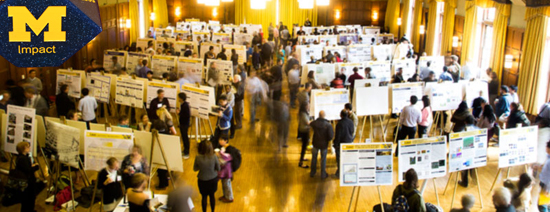MCubed A Year Later: A record of fostering innovative research
Several of the cubes enabled research to progress to the point that faculty are applying for larger grants to continue the work.

 Enlarge
Enlarge
The first annual MCubed Symposium, November 15, 2013, served as a showcase for the 200+ projects that came into being thanks to the MCubed initiative.
The idea for MCubed, which originated in the College of Engineering and spread to the entire University, was to partially fund faculty research for one year – enough to fund one graduate student for the same time period. To be approved as a cube, a group must have 3 members, with at least 2 from different departments, and the research project must be novel, high-risk and potentially transformative.
Is MCubed fulfilling its purpose? Yes- judging by the evidence in ECE!
Several of the cubes enabled research to progress to the point that our faculty are applying for larger grants to continue the work. Papers are being submitted to conferences and journals, and at least one company will be founded based on the research conducted as part of MCubed projects.
Of the approx. 220 cubes of research happening at the University of Michigan, 18 currently have a connection to ECE. And those cubes are easily proving the value of the program.
Our faculty are joining forces with others in the medical school, in Architecture, Astronomy, Political Science, Psychiatry, Nursing, the U-M Transportation Institute, as well as other departments in the College of Engineering, to battle cancer, uncover the origin of diseases, monitor the nation’s infrastructure, diagnose brain disorders, improve lighting, treat glaucoma and paralysis, even tackle questions about the Universe.
Click here for a brief description of the ECE cubes.
Here are the titles:
- Low power electronics for brain machine interface applications
- A Novel Glaucoma Drainage Device
- Reconfigurable graphene beams for microscopy and micromanipulation
- High-resolution imaging of fat tissue metabolism
- Big Data in astronomy: U-M astroinformatics research group
- Virtual reality as a surrogate sensory environment for evaluation of human luminous environment
- Using satellite data to study how variation in energy access can lead to economic, political instability
- COOL-Plasma: Efficient cold-plasma generation for applications in spacecraft propulsion and wound treatment
- Pattern classification for discovery of biomarkers of psychiatric disease
- ALDH inhibitors as cancer differentiation therapy
- Imaging Fleeting Thoughts
- National Infrastructure for Sensor Networking
- Enabling Patient-Centered Care With Advanced Mobile Monitoring
- Efficient Electromagnetic Energy Harvesting for Wireless Sensors
- Biophysical Manipulation of Functional Amyloids
- A Fast Surface Integral Equation Solver for the Radiative Transfer Equation
- Neutron Detection for Cancer Therapy
- A mathematical, scientific and measurement framework for the assessment of water balance and water quality
And now, one year later, a new wrinkle has been added in the MCubed world. In the spirit of entrepreneurial speed and freedom, outside investors are invited to participate in the excitement. The MCubed group says it is “an unprecedented opportunity for companies, alumni and friends to invest in research projects that align with their interests, from healthcare to arts preservation, from sustainability to big data! What’s your passion?”
Want to fund faculty to work on your own cube? Learn more here.
 MENU
MENU 
